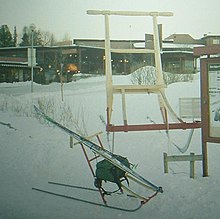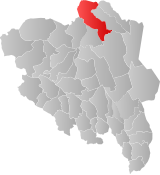|
Tynset
Tynset is a municipality in Innlandet county, Norway. It is located in the traditional district of Østerdalen. The administrative centre of the municipality is the village of Tynset. Other villages in Tynset include Fådalen, Fåset, Telneset, Tylldalen, and Yset. The 1,880-square-kilometre (730 sq mi) municipality is the 43rd largest by area out of the 356 municipalities in Norway. Tynset is the 166th most populous municipality in Norway with a population of 5,628. The municipality's population density is 3.1 inhabitants per square kilometre (8.0/sq mi) and its population has increased by 1% over the previous 10-year period.[4][5] General informationThe parish of Tønsæt was established as a municipality on 1 January 1838 (see formannskapsdistrikt law). In 1864, the southern part of the municipality (population: 3,216) was separated to form the new municipality of Lille-Elvdal. This left Tynset with 2,975 residents. During the 1960s, there were many municipal mergers across Norway due to the work of the Schei Committee. On 1 January 1966, the neighboring municipality of Kvikne was dissolved and on that date the southern part of Kvikne (population: 664) was merged into Tynset municipality. On 1 January 1970, the Garlia farm (population: 5) was transferred from Tynset to the neighboring Rennebu Municipality (which also meant switching from Hedmark county to Sør-Trøndelag county). On 1 January 1984, the unpopulated Spekedalen area was transferred from Tynset to the neighboring Rendalen Municipality.[6] NameThe municipality (originally the parish) is named after the old Tynset farm (Old Norse: Tunnusetr) since the first Tynset Church was built there. The first element is the genitive case of the river name Tunna (now spelled Tonna). The meaning of the river name is not known. The last element is setr which means "mountain pasture" or "farm".[7] Historically, the name of the municipality was spelled Tønset (pronounced Teunset with the "eu" diphthong equivalent to that in the French word bleu). On 3 November 1917, a royal resolution changed the spelling of the name of the municipality to Tynset.[8] Coat of armsThe coat of arms was granted on 18 October 1985. The official blazon is "Azure, a moose head issuant argent" (Norwegian: I blått et oppvoksende sølv elghode). This means the arms have a blue field (background) and the charge is a stylized moose head extending up from the base of the escutcheon. The moose head has a tincture of argent which means it is commonly colored white, but if it is made out of metal, then silver is used. The design was chosen to symbolize the abundance of moose in the area. The arms were designed by Nils Aas. The municipal flag has the same design as the coat of arms.[9][10][11] ChurchesThe Church of Norway has four parishes (sokn) within the municipality of Tynset. It is part of the Nord-Østerdal prosti (deanery) in the Diocese of Hamar.
Geography Tynset is the urban centre for the northern Østerdalen part of Innlandet county in the central area of mainland Norway. Tynset lies in the upper quadrant of Norway's longest valley, Østerdalen at an elevation of approximately 480 metres (1,574.8 ft) above sea level. To the northeast lies the municipality of Tolga; south of Tynset are Rendalen and Alvdal municipalities; and to the west is Folldal municipality. In the neighboring county of Trøndelag, Tynset is bordered to the north by the municipalities of Rennebu and Midtre Gauldal, and to the west by Oppdal municipality. Tynset is known for its vast areas of forest and mountain, which are ideal for skiing, walking, cycling, hunting, and fishing. In many areas are signposted paths and ski tracks are ploughed in winter. The river Glåma has several side rivers including the Sivilla and Ya. The Fådalen valley and the lake Savalen have many tourist activities. The lakes Innerdalsvatnet and Falningsjøen also lie in the municipality. Tynset has many wildlife areas including the geological formation at Ripan and Gammeldalen. At Ripan, there is a lake formed by glaciation during the last ice age and at Gammeldalen there are some beautifully formed corries from the same period. Tynset has many historic mountain farms (seter) that are still in use in the high parts of the countryside. It is possible to visit these farms while hiking. Tynset municipality also rents chalets, which used to belong to some of these mountain farms. GovernmentTynset Municipality is responsible for primary education (through 10th grade), outpatient health services, senior citizen services, welfare and other social services, zoning, economic development, and municipal roads and utilities. The municipality is governed by a municipal council of directly elected representatives. The mayor is indirectly elected by a vote of the municipal council.[12] The municipality is under the jurisdiction of the Østre Innlandet District Court and the Eidsivating Court of Appeal. Municipal councilThe municipal council (Kommunestyre) of Tynset is made up of 27 representatives that are elected to four year terms. The tables below show the current and historical composition of the council by political party.
MayorsThis is a list of the mayors (Norwegian: ordfører) of Tynset since it was established on 1 January 1838.[33]
ClimateTynset has a boreal climate (continental subarctic climate). Situated inland on the valley floor at 480 meter altitude and sheltered by mountain ranges, Tynset can see strong inversion for long periods. The all-time low is −46.6 °C (−51.9 °F) from 1 February 1912, (Tynset-Åkrann),[34] and the January record low is −46.1 °C (−51.0 °F) from 1 January 1979.[35] In the European cold snap of January 2010 Tynset recorded low of −42.4 °C (−44.3 °F). Tynset has recorded the coldest June low for a town in mainland Norway with −7.9 °C (17.8 °F) on 1 June 1907. The all-time high is 31.4 °C (88.5 °F) recorded 25 June 2020, while July has seen 31.3 °C (88.3 °F) on 27 July 2008. Tynset sees sparse precipitation with only 440 mm (17.3 in) annually, with February - April as the driest season.
Transportation The municipality can be reached via railroad, road, and air. The main Norwegian National Road 3 runs through the municipality (it is the shortest route between the cities of Oslo and Trondheim). The Rondevegen road connects Tynset to Lillehammer (to the south), Røros (to the northeast), and continues further into Sweden. County Road 30, which passes through Rendalen, also continues through Tynset into Sweden. The Rørosbanen railway line connects Tynset with the major cities of Oslo and Trondheim. Røros Airport, 55 kilometres (34.2 mi) away, is part of the national network. Tynset also hosts an aerodrome that is used by smaller aircraft. Kickers Tynset produces the traditional Norwegian form of transportation, the "kicker" (spark). It is made in two versions: Rappen and Tarzan. The world's largest kicker is located in the Tynset Square in the village of Tynset. This sculpture is four times the size of a normal kicker. EconomyWith a population of about 5,400 people, Tynset is the urban centre of the Nord-Østerdalen region. Although it is a modern business and shopping centre with a wide variety of commercial activities, agriculture and forestry are still the traditional ways of making a living. Municipal administration and service industries, such as the computer industry, law, finance, and construction are also beginning to play an increasing role. Tynset has most of the functions of a regional centre because of its schools and hospital, and many of the region's intermunicipal services have naturally been positioned in Tynset: The Family Centre, Centre for School Psychology, and others. A factory in Tynset used to produce latex Troll souvenirs, but production moved abroad and it no longer does this. Culture
Tynset has a rich cultural life with a huge range of organisations in sports, music, drama, the arts, and youth work.
The Centre for The Arts (kulturhuset) opened in 1988. The centre houses concerts, plays, a cinema, library, art exhibitions, rehearsals, reunions, conferences, and festivals. The Kulturhuset also has a café.
Tynset's first sports hall (Tynsethallen) was built in 1986. A second sports hall (Holmenhallen) was opened ten years later. A swimming pool and smaller gymnastics gall in the building connects them to form a complete set of sports facilities.
Savalen is known internationally for its speed skating ice rink, where many national and international records have been achieved. Savalen has also developed a football pitch, an arena for Nordic skiing and biathlon, a roller skiing track, an alpine area, and 90 kilometres (55.9 mi) of cross-country skiing tracks. The Savalen area has become a place that is specially designed for the handicapped, which includes wheelchair paths and a specially equipped fishing pier. Savalen has become a well-known holiday and vacation area.
Tynset had one of Norway's very first pro skateboard vert ramp, it was constructed 1981-82 by Erik Snedsbøl and located in the forest near Tela Sag & Høvleri on Telneset. It was one of the first pro vert-ramp's during the prohibition period (1978–89) in Norway. From 7 September 1978 to 9 May 1989, skateboarding was completely banned in Norway. At that time, Norway was the only country in the world where it was forbidden to sell, buy or stand on a skateboard. The ban was introduced by the Nordli government and lifted by the Brundtland government, both emanating from Arbeiderpartiet (Norwegian Labour Party). Snedsbøl's skateboard ramp was the first to get permission for use in Norway during the prohibition period, and contributed to the softening of the Law of Norway. The newspaper Arbeidets Rett by Jan E. Øvergård published an article on 12 October 1983. The ramp was later published in the Swedish skateboard magazine Uppåt Väggarna (no. 5/6, 1983). Notable people
Sport
Attractions The following are some of the attractions in the area. The distance from the municipal center of Tynset is shown.
References
External linksWikimedia Commons has media related to Tynset. Look up Tynset in Wiktionary, the free dictionary.
|
||||||||||||||||||||||||||||||||||||||||||||||||||||||||||||||||||||||||||||||||||||||||||||||||||||||||||||||||||||||||||||||||||||||||||||||||||||||||||||||||||||||||||||||||||||||||||||||||||||||||||||||||||||||||||||||||||||||||||||||||||||||||||||||||||||||||||||||||||||||||||||||||||||||||||||||||||||||||||||||||||||||||||||||||||||||||||||||||||||||||||||||||||||||||||||||||||||||||||||||||||||||||||||||||||||||||||||||||||||||||||||||||||||||||||||||||||||||||||||||||||||||||||||||||||||||||||||||||||||||||||||||||||||||||||||||||||||||||||||||||||||||||||||||||||||||||||||||||||||||||||||||||||||||||||||||||||||||||||||||||||||||||||||||||||||||||||||||||||||||||||||||||||||||||||||||||||||||||||||||||||||||||||||||||||||||||||||||||||||||||||||||||||||||||||||||||||||||||||||||||||||





